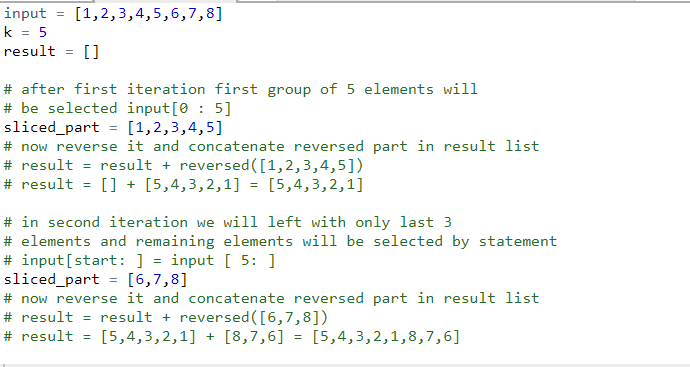Python Slicing | Reverse an array in groups of given size
Last Updated :
13 Apr, 2023
Given an array, reverse every sub-array formed by consecutive k elements. Examples:
Input:
arr = [1, 2, 3, 4, 5, 6, 7, 8, 9]
k = 3
Output:
[3, 2, 1, 6, 5, 4, 9, 8, 7]
Input:
arr = [1, 2, 3, 4, 5, 6, 7, 8]
k = 5
Output:
[5, 4, 3, 2, 1, 8, 7, 6]
Input:
arr = [1, 2, 3, 4, 5, 6]
k = 1
Output:
[1, 2, 3, 4, 5, 6]
Input:
arr = [1, 2, 3, 4, 5, 6, 7, 8]
k = 10
Output:
[8, 7, 6, 5, 4, 3, 2, 1]
We have existing solution for this problem please refer Reverse an array in groups of given size link. We can solve this problem quickly in Python using list slicing and reversed() function.Below example will give you better understanding of approach.
Example:

Python3
def reverseGroup(input,k):
start = 0
result = []
while (start<len(input)):
if len(input[start:])<k:
result = result + list(reversed(input[start:]))
break
result = result + list(reversed(input[start:start + k]))
start = start + k
print(result)
if __name__ == "__main__":
input = [1, 2, 3, 4, 5, 6, 7, 8]
k = 5
reverseGroup(input,k)
|
Output:
[5, 4, 3, 2, 1, 8, 7, 6]
Using Direct Function
Python3
def reverseGroup(a, k):
res = []
for i in range(0, len(a), k):
res.extend((a[i:i + k])[::-1])
print(res)
if __name__ == "__main__":
input = [1, 2, 3, 4, 5, 6, 7, 8]
k = 5
reverseGroup(input, k)
|
Output:
[5, 4, 3, 2, 1, 8, 7, 6]
Approach#2: Using slicing and reversing the chunks
The given code takes an array and a group size as input. It iterates through the array in chunks of size k and reverses each chunk using slice notation. Finally, it concatenates all the chunks to form the final reversed array.
Algorithm
1. Initialize an empty list to store the final output
2. Iterate through the input list in steps of size k
3. For each step, slice the list from the current index to k elements ahead and reverse it
4. Append the reversed slice to the output list
If there are any remaining elements at the end of the list, reverse them and append to the output list
5. Return the output list
Python3
def reverse_groups(arr, k):
output = []
for i in range(0, len(arr), k):
chunk = arr[i:i+k]
output += chunk[::-1]
return output
arr = [1, 2, 3, 4, 5, 6, 7, 8, 9]
k = 3
print(reverse_groups(arr, k))
arr = [1, 2, 3, 4, 5, 6, 7, 8]
k = 5
print(reverse_groups(arr, k))
arr = [1, 2, 3, 4, 5, 6]
k = 1
print(reverse_groups(arr, k))
arr = [1, 2, 3, 4, 5, 6, 7, 8]
k = 10
print(reverse_groups(arr, k))
|
Output
[3, 2, 1, 6, 5, 4, 9, 8, 7]
[5, 4, 3, 2, 1, 8, 7, 6]
[1, 2, 3, 4, 5, 6]
[8, 7, 6, 5, 4, 3, 2, 1]
Time complexity: O(n), n is length of array
Auxiliary Space: O(n)
Approach#3: Using list comprehension
Here is the solution to reverse an array in groups of given size using list comprehension:
Algorithm:
Initialize an empty list to store the final output.
Create a list comprehension to iterate through the input list in steps of size k.
For each step, slice the list from the current index to k elements ahead and reverse it using the slice notation.
Append the reversed slice to the output list using the list concatenation operator ‘+’.
If there are any remaining elements at the end of the list, reverse them and append to the output list using the same list comprehension syntax.
Return the output list.
Python3
def reverse_groups(arr, k):
return [val for i in range(0, len(arr), k) for val in reversed(arr[i:i+k])]
arr = [1, 2, 3, 4, 5, 6, 7, 8, 9]
k = 3
print(reverse_groups(arr, k))
arr = [1, 2, 3, 4, 5, 6, 7, 8]
k = 5
print(reverse_groups(arr, k))
arr = [1, 2, 3, 4, 5, 6]
k = 1
print(reverse_groups(arr, k))
arr = [1, 2, 3, 4, 5, 6, 7, 8]
k = 10
print(reverse_groups(arr, k))
|
Output
[3, 2, 1, 6, 5, 4, 9, 8, 7]
[5, 4, 3, 2, 1, 8, 7, 6]
[1, 2, 3, 4, 5, 6]
[8, 7, 6, 5, 4, 3, 2, 1]
Time Complexity: The time complexity of this solution is O(n/k) because we are iterating through the input list in steps of size k.
Auxiliary Space: The space complexity of this solution is O(n) because we are creating an output list to store the reversed subarrays.
Like Article
Suggest improvement
Share your thoughts in the comments
Please Login to comment...